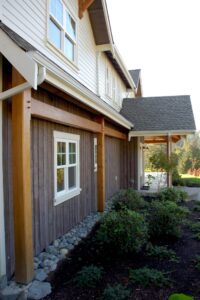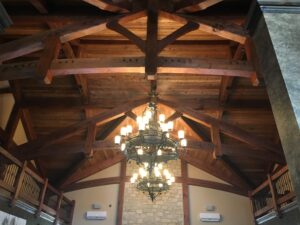Timber Frame Care Compared to Regular Home Care
Timber frame homes are admired for their timeless beauty, strength, and craftsmanship. But when it comes to maintenance, many people wonder—how does caring for a timber frame home differ from a conventional stick-built house? The good news: while timber frames require some specific attention, they are often easier to care for in the long run. Let’s explore how timber frame care compares to standard home maintenance.
Structural Durability and Longevity
-
Timber Frame:
Heavy timber construction is inherently durable. The massive timbers resist decay, pests, and movement better than the smaller dimensional lumber used in conventional homes. Timbercraft provides our frames with proper design (good roof overhangs, proper drainage), ensuring our structural frame needs little attention beyond periodic inspections. -
Regular Home:
Stick-built homes rely on smaller framing members that can be more susceptible to moisture damage, rot, and shifting over time. Hidden framing problems may go unnoticed until significant repairs are needed.
Key takeaway: Timber frame structures are often more forgiving and long-lasting with minimal intervention.
Exterior Maintenance
-
Timber Frame:
If your timber frame is exposed on the exterior (as in some hybrid or full timber designs), the wood needs protection. This may include applying stains or sealers every 5–10 years to guard against UV damage and moisture. Timbercraft initially coats our frames with oil based stains that provide 99% UV protection with defense against mold, mildew and algae (when choosing one of our pre-selected colors) -
Regular Home:
Vinyl siding, fiber cement, or painted wood on conventional homes also requires maintenance—typically repainting every 7–10 years or washing and inspecting siding for cracks or warping.
Key takeaway: Both home types need exterior upkeep, but timber frames usually require less frequent treatments if high-quality finishes are used initially.
 Interior Timber Care
Interior Timber Care
-
Timber Frame:
Exposed beams inside require very little maintenance beyond dusting or occasional cleaning. The natural beauty of the wood stands the test of time without repainting or refinishing. -
Regular Home:
Drywall, trim, and painted surfaces may need regular touch-ups, repainting, or repairs from settling cracks and everyday wear.
Key takeaway: Interior timber is low-maintenance compared to standard painted or finished interior materials.
Settling and Movement
-
Timber Frame:
Timber frames are designed to allow for minor wood movement as the house adjusts to moisture changes. This is a natural part of the structure and rarely affects stability. -
Regular Home:
Stick-framed homes can settle unevenly over time, leading to nail pops, drywall cracks, or shifting floors that may need repair.
Key takeaway: Timber frames handle natural settling gracefully without frequent cosmetic fixes.
Pest and Moisture Resistance
-
Timber Frame:
Large timbers are less vulnerable to termites and rot, provided moisture is managed properly. The wood mass itself helps regulate indoor humidity, adding to the home’s resilience. -
Regular Home:
Conventional framing, hidden behind drywall and siding, can become a hidden target for pests and rot if leaks develop.
Key takeaway: Timber frames are naturally more resistant but still rely on good design to keep water and pests out.
Conclusion: A Care Investment That Pays Off
While all homes require maintenance, timber frame homes stand out for their enduring strength and lower upkeep demands over time. With basic care—like keeping timbers dry, inspecting finishes, and cleaning as needed—your timber frame will reward you with generations of beauty and performance.
Interested in getting a free quote for your project? Timbercraft offers free proposals, giving you an idea of what to expect when it comes to timber frame builds. Feel free to contact us for your free proposal email at [email protected] or call 734-864-9790
